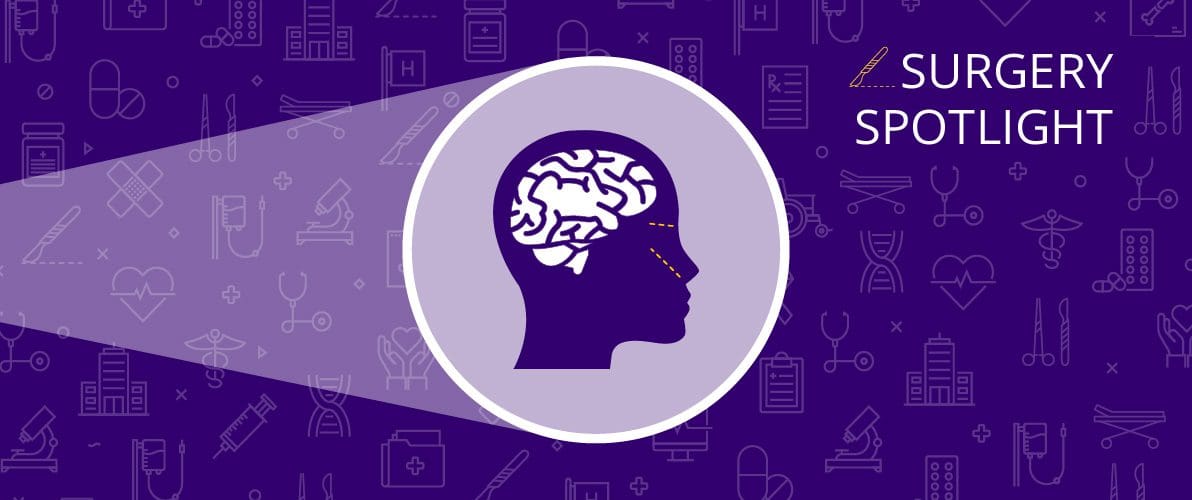Highlights | Simplifying skull base surgery
- Traditional skull base surgery requires temporarily removing part of the skull to access the brain, which can cause complications and long hospital stays.
- Transorbital neuroendoscopic surgery (TONES) requires only a tiny incision by the eyelid.
- Patients recover quickly with minimal side effects; some can go home the same day.
- TONES was developed by UW Medicine surgeons in 2010.
There’s a reason “it’s not brain surgery” is an idiom that exists: Brain surgery is complex and difficult. Operating on the brain means operating on our defining organ.
Traditional brain surgery, performed via a craniotomy, involves cutting and removing a section of the skull to reach the brain. Unsurprisingly, this procedure can result in long recoveries and potential complications.
Over the past decade, however, a new procedure offers a different route to pathology of the brain and skull base, eliminating the need to remove part of the skull. It’s called transorbital neuroendoscopic surgery, or TONES, and can make brain surgery easier than, well, brain surgery.
How is the surgery performed?
Kris Moe, MD, FACS, a head and neck surgeon and chief of Facial Plastics and Reconstructive surgery, pioneered TONES in 2010 along with Richard Ellenbogen, MD, FACS, a neurosurgeon and professor and chair of the Department of Neurological Surgery, and Moe’s fellow at the time, Chris Bergeron, MD.
The procedure is a less disruptive way to access the skull base — a set of five bones that support the bottom of the brain — to remove tumors, treat aneurysms, fix cerebrospinal fluid leaks, repair skull and orbital fractures, and more. Surgeons go in through a two-centimeter incision above the eye and use an endoscope, which Moe describes as a “small telescope.”
“The orbits reach back almost to the center of the skull, so between both of them you can access many parts of the brain, and by going around the eye you already have a little tunnel through which you can get way back into the head without retracting the brain,” he says.
TONES is sometimes referred to as transorbital skull base surgery, too. But don’t let the “transorbital” fool you: The eye is not removed during the procedure but is instead protected in the orbit, Jacob Ruzevick, MD, a neurosurgeon who specializes in neuro-oncology and skull base tumors, wants people to know.
When Moe and Ruzevick work together, Moe guides the endoscope while Ruzevick removes the tumor. (And yes, they’re both working through that 2 cm incision.)
“We call it a dance; you have to dance with your partner to achieve the best outcome,” Ruzevick says.
What are the benefits for patients?
Moe likes to call TONES “minimally disruptive” rather than “minimally invasive” because the tumor or other reason for surgery is already invasive, but the treatment doesn’t have to completely disrupt their life.
“We can be minimally disruptive to your lifestyle, to how you function, and get you back to your quality of life as soon as possible with rapid recovery, less expense, a shorter hospital stay and less time needed off work,” he explains.
Most patients don’t even get a scar after — and if they do, it’s small and covered by the eyelid, so no one notices it.
Depending on the location, size and other factors of the tumor or other problem to be fixed, the surgery also takes much less time than a craniotomy. Since the incision is so small, there’s less pain and less recovery time, with some people able to go home the same day as the procedure.
“It makes patients feel a lot easier going into surgery. For example, one of my recent patients said he had no pain after,” Moe says.
Of course, no surgery is without risk, though lasting complications are rare for TONES patients.
“When you retract the eye, the lens of the eye gets deformed temporarily, and temporary blurry vision can happen. But it almost universally resolves,” Ruzevick explains.
What is it like to perform this procedure?
The first decision Moe and Ruzevick must make is whether a patient qualifies for TONES — and there are a whole host of factors to consider.
“It depends on the structures involved. What critical structures are adjacent to the tumor and is the tumor invading them? What’s the size of it? Are there blood vessels feeding it or around it? Is the optic nerve near it?” Moe says. It’s a complex analysis that takes a wealth of experience, a factor owing to UW Medicine’s leadership in the field, given Moe’s pioneering experience.
It’s also why there are few surgeons in the U.S. who can perform TONES, though Moe says that is starting to change, and international adoption of the technique has been more rapid.
A patient’s personal health history matters too when determining if they are eligible, though Moe and Ruzevick have successfully operated on everyone from infants to individuals in their 90s.
Moe and Ruzevick sometimes also work with an ophthalmologist, depending on the location of the surgery.
“I am incredibly grateful and humble to do this for people. It feels great to be on the forefront of neurosurgery and neuro-oncology. You always want to be constantly improving to minimize stress, harm and pain for patients, and this is a natural avenue to do just that,” Ruzevick says.
Moe couldn’t agree more.
“It’s really rewarding to see patients recover so quickly,” he says. “I really enjoy my work. It gives me a lot of satisfaction.”



